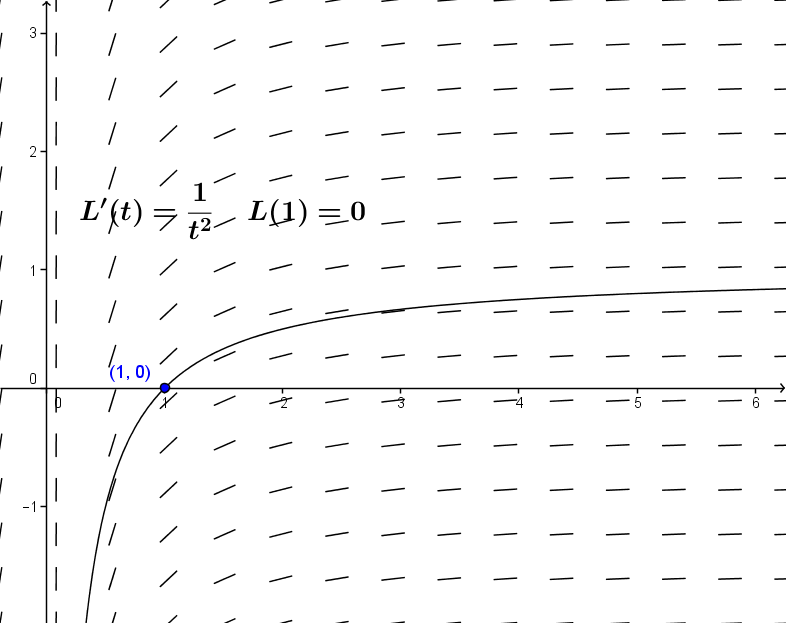
We have already explored one model for learning in which the
learning
rate was a positive decreasing function of time, i.e. $ L'(t) = \frac 1t$. The
solution to this model with the initial condition $L(1) = 0$ led us to
the
natural logarithm and a model for learning that had the values of $L(t)$
unbounded in the sense that for any number $B$ there was some $t$ where
$L(t)
> B$. Although this model is very encouraging in terms of the
unbounded
increase in learning, it does not match very well with much experience.
In many situations there are bounds to what can be learned no matter
how
much time is spent in the process. In trying to find a model for such a
learning curve, we examine a similar rate of learning that is positive
but less than $\frac 1t$.

Example VI.D. 1. Suppose $L_2'(t)= \frac 1{t^2}$ and $L(1) = 0$. Find $L_2(2)$ and discuss the value of $L_2(t)$ when $t > > 0$.
Solution: This problem is not too hard since $G(t) = \frac {-1}t$ has
$G'(t)= \frac 1{t^2}$. Thus $L_2(t) = \frac{-1}t + C$. Solving for
$C$ we use $0 = L_2(1) = -1 + C$ so $C = 1$ and
$L_2(t) = 1 - \frac 1t$ for all $t > 0$.
To respond to the problem, we have $L_2(2) = 1 - \frac12 = \frac 12$
.When $t > > 0$ then $L_2(t)$ is close to $1$.
Comment:
We
now have a model for learning with bounded growth. At this stage we'll
modify the differential equation just slightly and consider the same
questions
for a derivative function for which we do not yet have an
antiderivative.
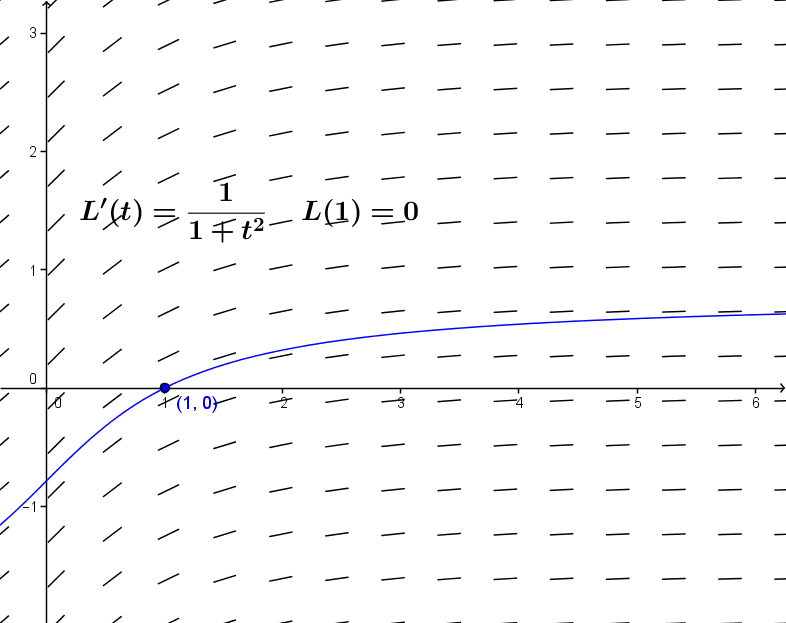
Solution:
At this stage we have no elementary function which
has $\frac 1{1+t^2}$ for its derivative.
Looking at the tangent
field
and a sketch of the integral curve for this differential equation gives
some idea of the shape of the solution. [See Figure VI.D.2]
We consider $A'(t)$ and $L_2'(t)$ as the rates at which the
amount
learned is changing.
Then since $\frac 1{1 + t^2} < \frac 1{t^2}$ for any $t >
1$, the amount learned at any time $t$ according to the $L_2(t)$
model is larger than that learned according to the $A(t)$ model. [See
Figure
VI.D.3.]
$A(t)$ is increasing for all $t$, yet since $0 = A(1) = L_2(1)$
and as $t$ gets large, $L_2(t) \rightarrow 1$,
it must be that $A(t) < L_2(t) < 1$ for all $t$ .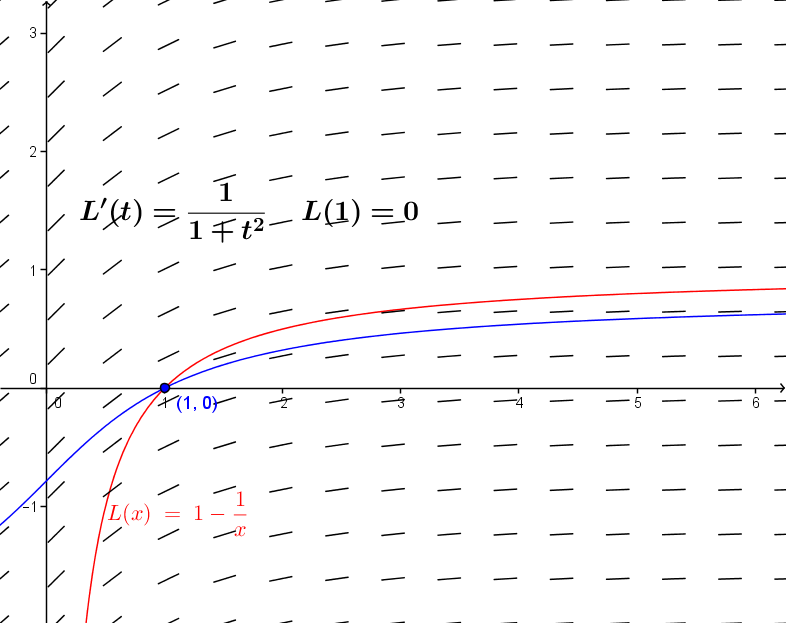
By careful analysis of this situation it should seem reasonable that
as $t$ gets large, $A(t)$ approaches some
specific
number that is at most $1$.
Later this section we will see what this
number
is, but for now we continue our analysis to try to find $A(2)$.
First, as we did with the model for L(t), we can estimate A(2) using
Euler's method.[Can you explain why this is an overestimate?]
| t | A | A'(t)=1/(t2+1) | dA=A'(t)*dt |
| 1 | 0 | 0.5 | 0.125 |
| 1.25 | 0.125 | 0.390243902 | 0.097560976 |
| 1.50 | 0.222560976 | 0.307692308 | 0.076923077 |
| 1.75 | 0.299484053 | 0.246153846 | 0.061538462 |
| 2.00 | 0.361022514 | 0.2 | 0.05 |
This is easy enough in theory because of the fundamental theorem of calculus, but it doesn't express the funtion A as any elementary function that we have studied yet in the calculus.
To develop this differential equation further we introduce a slight variation on the function A, changing the initial condition of the differential equation to arrive at a more enlightening solution.
Suppose A 0'(t) = 1/(1+t 2) and A 0(0) = 0. Then since A'(t) = A 0'(t) for all t, A(t) = A 0(t) + C for some constant C. We'll come back to A(t) later in this section, but now we'll focus on A 0.
To understand A 0, we look at F(x) º A 0( tan(x)). Using the chain rule and the derivative of the tangent function together with the differential equation defining A 0 we have that
Now this means that for all x in (-pi /2,pi /2), F(x) = x + K for some constant K. Evaluating F at 0, we see that F(0) = A 0( tan(0)) = A 0(0) = 0 = 0 + K, so F(x)= x for all x in (-pi /2,pi /2). This means that for these value of x, A 0(tan(x)) = x
But the function that satisfies this property is the arctangent
function.
Thus A 0(t) = arctan(t) for all t.
This result can be expressed in a more direct fashion, namely, arctan'(t)
=
1/(1+t 2).
Example VI.D.2 (continued) From the last result we have that
A(t)
= arctan(t) + C and therefore
0 = A(1) = arctan(1) + C = pi /4 + C. So
C = -pi /4 and A(t) = arctan(t) - pi
/4.
Recalling the basic properties of the arctangent function allows us to answer the original questions about A.
Derivatives of Inverse Trigonometric Functions.
At this point we'll stop a moment to give a more geometric
justification
of the result on the derivative of the arctangent. We'll use the same
technique
to find the derivative of the arcsine function, leaving the derivatives
of the arccosine and the arcsecant as exercises.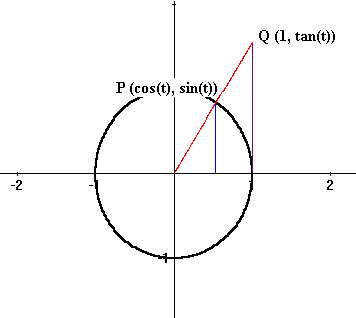
Theorem VI.D.1: For all x , arctan'(x) = 1/(1 + x 2).
Proof: Recall that tan'(t)=sec 2(t) for all t in (-pi /2,pi /2).
Recall also that the tangent function can be visualized by drawing
an
arc of length t on a unit circle to determine the point P with
coordinates
(cos(t), sin(t)), drawing the radius through P to meet the tangent line
to the circle X=1 at the point Q with coordinates (1,tan(t)). [See
Figure
VI.D.4.]
Now a change of angle, dt, gives a corresponding change in the position of Q, called dy where y=tan(t) . Then the ratio dy/dt is approximately sec 2(t) so the ratio of dt/dy is approximately 1/sec 2(t). But t is the arctan(y). Now when dy -> 0,
dt/dy -> 1/sec 2(t), so we have arctan'(y) = 1/sec 2(t) = 1/(1+tan 2(t)) = 1/(1 + y 2).
Changing the name of the variable completes the argument. EOP
Corollary VI.D.2:![]() .
.
We now turn our attention to the inverse function of the sine, called the arcsine.
Theorem VI.D.3: For x with -1 < x < 1 , arcsin'(x) = 1 / sqrt
(1-x 2).
Proof: Recall that sin'(t) = cos(t) for all t in
(-pi /2,pi /2)
.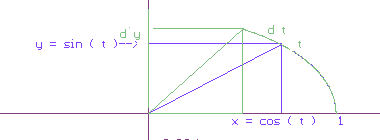
The sine function can be visualized [See Figure VI.D.5.] by drawing
an arc of length t on a unit circle to determine the point P with
coordinates
(cos(t), sin(t)), then drawing the horizontal line through P to meet
the
vertical axis at the point S with coordinates (0,sin(t)).
Now a change of angle, dt, gives a corresponding change in the position of S, called dy where y=sin(t). Then the ratio dy/dt is approximately cos(t) so the ratio of dt/dy is approximately 1/cos(t). But t is the arcsin(y) so when dy -> 0, dt/dy -> 1/cos(t). Thus we have
Changing the name of the variable completes the argument. EOP
Corollary VI.D.4:![]() .
.
Theorem VI.D.5: For x with -1 < x < 1 , arccos'(x) = -1
/ sqrt (1-x 2).
Proof: Though a detailed proof of this result can be obtained using the derivative of the cosine (see exercise 19), the fact is most easily understood by noting that arccos(x) = p /2 - arcsin(x). EOP.
Theorem VI.D.5: For x with 1 < x or x < -1 , arcsec'(x) = 1/[ x sqrt(x 2 - 1)].
Proof: Left as an exercise.
Comments: The derivatives of functions involving the inverse
trigonometric functions are found using rules for differentiation
examined
previously in Chapter III. Applications of these functions arise in
situations
where angle measurement can be used to control some other measurement.
What is somewhat more difficult is recognizing these functions in
integration
problems. Unlike differentiation, there are no completely general
methods
for attacking integration. We will explore some further integration
methods
later, but for now here are two examples showing how substitution can
come
into play to find integrals related to the arctangent.
Example VI.D.iii. Find a) and
b)
and
b)![]() .
.
Solution: a) Let u = exp(x) so that du = exp(x) dx and this integral becomes
b) Let u = 1 + x, so that du = dx and this integral becomes
Comment: Integrals related to the arcsine function also can be complicated by substitutions and the need to recognize an appropriate choice for the substitution. In b) this meant supposing that 2 + 2x + x 2 = 1 + u 2. Solving for u we now have u 2 = 1 + 2x + x 2 = (1 + x) 2 so u = 1 + x and we can continue.
Exercises VI.D
Find derivatives for the following functions:



There are many more possible models for learning that involve positive, decreasing functions. For problems 25-30 assume that L'(t) = P(t) and L(1) = 0.